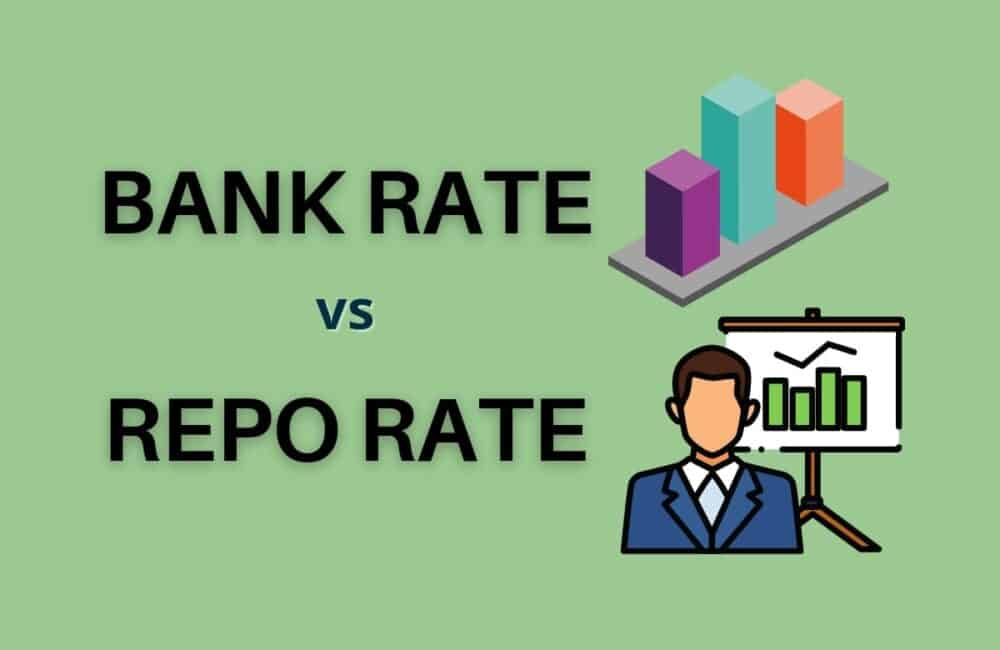Bank rate and repo rate are instruments of regulating liquidity and inflation in an economy. The most important difference while comparing bank rate vs repo rate is the tenure of the borrowings availed from the central bank by the commercial banks. The bank rate is mainly used by banks to satisfy their long-term financial goals and requirements while the repo rate is involved while dealing with short-term loans.
What Is Bank Rate?
The bank rate is defined as the interest rate at which the central banks provide loans to commercial banks and other financial institutions. This rate is applied to the long-term lending of loans. In India, it is done by the Reserve Bank of India (RBI). It doesn’t include discounting/rediscounting of bills of exchange.
The institutions that borrow through this facility include commercial banks, the Government of India, State governments, financial institutions, cooperative banks, and NBFCs. The bank rate directly influences the long-term lending activities of the concerned lending institutions including commercial banks.
A bank rate cut by the central bank is seen as a token move to increase liquidity in the market. A reduction in bank rate makes borrowings cheaper. It also increases purchases on credit. It improves the flow of funds and spurs business activity within the economy. Whenever a central bank wants to curb liquidity (reduce the supply of money) in the market, it raises the bank rate.
The bank rate was realigned with the Marginal Standing Facility (MSF).
What Is Repo Rate?
Repo rate is defined as the interest rate at which banks borrow funds from the central bank against eligible collaterals by selling their securities to the central bank. Unlike the bank rate, the repo rate is charged by the Reserve Bank of India on its short-term lending (usually when there is a liquidity crunch). In western economies, the repo rate is known as the “rate of discount”. On the other hand, the reverse repo rate is the rate at which commercial banks place their surplus funds or extra money with the central bank. Repo stands for “Repurchasing Option”.
In technical terms, a repo rate is a type of discount on dated government securities. These government securities are surrendered or deposited by commercial banks and other financial institutions to avail short-term loans. When the banks seek to get their securities back from the central bank, the value of the dated securities is reduced by an amount equivalent to the prevailing repo rate at that time.
The repo rate is used by banks for overnight borrowings and the inter-bank market is also based on this rate. The Inter-bank market is better known as the “Call Money Market” of India. In addition to affecting the operational cost of the banks, the repo rate has a direct influence on their loan products. A reduction in the repo rate by RBI lowers the interest rate of loans offered by banks to their customers.
The repo rate is an important indicator of the monetary policy stance of the central banks worldwide.
In a measure to ensure deeper liquidity in the market and to promote enhanced lending by commercial banks, RBI has started offering long-term repo operations.
Recommended: How to Get Money from a Closed Bank Account?
Bank Rate Vs Repo Rate
The bank rate is always higher than the repo rate. While comparing bank rate vs repo rate, we must take into account the key objectives of the two rates. When a commercial bank borrows money from the central bank via a repo rate facility, it involves collaterals like securities, bonds, and agreements, etc. On the other hand, the long-term borrowings of commercial banks and other financial institutions from the central bank under the bank rate facility don’t include any collateral(Submitted as security).
Differences Between Bank Rate And Repo Rate
Since the borrowings through the bank rate initiative are available as long-term loans, the tenure of such loans is longer than a month. On the other hand, loans under the repo rate are meant to overnight and thus the tenure of such loans is usually one day.
One important difference between the bank rate and repo rate is the involvement of the repurchasing agreement. While there is an option of the repurchasing agreement (of securities, etc.) between the banks and the central bank in the repo rate loans, there is no such repurchasing involved in bank rate loans.
Recommended: Having Multiple Bank Accounts With Different Banks – Good Or Bad Idea?
Bank Rate Vs Repo Rate: 7 Key Differences In Points
Though the bank rate and repo rate are both fixed by the central bank, there are some important differences between the two. Here are 7 critical differences between bank rate and repo rate:
- The repo rate is an interest rate charged by the central bank when commercial banks repurchase the securities sold by them to the central bank. In bank rate, the loan is given at a fixed rate to the banks.
- Central banks always keep bank rates higher than the repo rate.
- Another difference between the bank rate and repo rate is their goal. Borrowings under the bank rate are useful in managing long-term financial goals while those in the repo rate are meant for the short-term financial needs of the banks.
- Borrowings under the bank rate are collateral-free. When central banks provide loans under the repo rate agreement, it involves collaterals like gold, securities, bonds, and agreements etc.
- Bank rates have a direct effect on the borrowing rates offered to the public/customers by the scheduled commercial banks. Repo rate usually doesn’t affect customers directly.
- Repo rate is a tool to regulate the liquidity in an economy and to control inflation while bank rate influences long term lending rates in an economy.
- The tenure of loans under bank rate is one month while it is one day in repo rate loans.
Final Thoughts
The central bank controls the money supply in the economy with the help of bank rates and repo rates. The macroeconomic stability of an economy depends on a central bank’s monetary policies. Bank rates and repo rates are two such instruments that affect the macroeconomic outlook of an economy.
Understanding the bank rate vs repo rate differences criteria is critical in developing the understanding of the economic stability of a country. Among instruments of monetary management, bank rate has become dormant and banks usually do not borrow funds under this facility. The Repo rate has emerged as the key instrument of monetary policy in almost all market economies.
Recommended: International Banks in India
Frequently Asked Questions
Who Decides The Bank Rate?
The bank rate is decided by the central bank in a country. In India, it is decided by the RBI.
What Is The Difference Between Bank Rate And Repo Rate?
The bank rate is the rate at which commercial banks borrow money from the central bank on a long-term basis. The repo rate is the rate of interest charged when government securities and bonds are deposited by banks to avail short-term loans.
Who Decides The Repo Rate?
The Repo rate is decided by the RBI.
What Is The Timeframe For Bank Rate And Repo Rate?
Bank rate is used for long-term borrowings having a tenure of 1 month or more. Repo rate is an overnight lending facility and hence, the tenure is one day.
What Is The Reverse Repo Rate?
The Reverse Repo rate is the rate at which the central bank borrows money from commercial banks.



